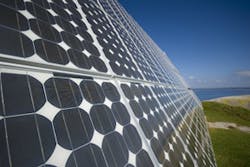Bright Outlook for Solar Cell Manufacturing Equipment Market
As the price of crude oil has soared to record-high prices, the demand for alternate energy sources — including solar, wind, nuclear, ethanol, and fuel cells — has also increased. But of all the alternative sources, solar energy is perhaps the most feasible to develop on a remote property and flexible enough to meet changing requirements.
A recent analysis from Palo Alto, Calif.-based Frost & Sullivan, “North American Solar Cell Manufacturing Equipment Markets,” says this market earned revenues of $260.2 million in 2007 and is projected to reach $1.2 billion in 2014.
According to Frost & Sullivan, there are clear cost advantages to installing solar panels compared to having transmission lines, particularly in areas that are not easily accessible. Moreover, solar cells are easier to manage and maintain than other sources, such as wind or nuclear.
In an effort to avert the looming energy crisis, governments have intervened to implement policies such as the Renewable Portfolio Standard (RPS), which mandates electricity retailers derive a fraction of their power from renewable energy sources like solar. Governments have supplemented these laws with several tax incentives and tax breaks for solar power generation. Although equipment vendors are working to improve efficiencies and increasing handling capacities, their efforts offset solar energy's high cost per watt (peak) compared to competing natural energy sources. The shortage of raw materials increases the cost of production.
Frost & Sullivan notes that polysilicon prices are as high as $200 per kilogram because silicon, which forms the base substrate for most solar modules, is currently experiencing a heavy shortage. Furthermore, the lack of raw materials is preventing many manufacturing plants from operating at 100% capacity, driving up the prices of solar modules and hence deterring potential investors.
Cyclically, diminishing end-user demand has forced manufacturers to slow production of solar modules. In turn, this will likely result in decreased sales of new equipment.
Scientists and solar cell manufacturing equipment companies have been aiming to develop advanced technologies in thin film substrates that offer higher efficiencies. Although the generation of 1 watt of power currently costs between $1.75 and $5.00, thin film substrates will help lower the prices to a more palatable $1.30 per watt by 2012. This technology's lower requirement of silicon combined with sizable energy savings is expected to boost new equipment sales.
For more information, visit www.smt.frost.com.
